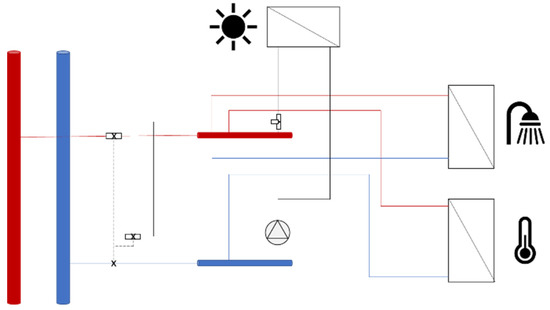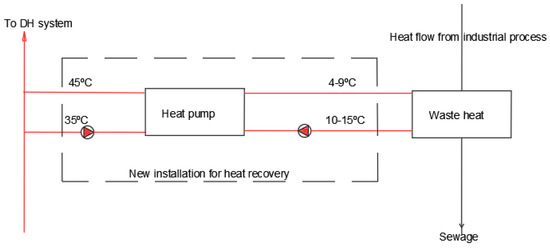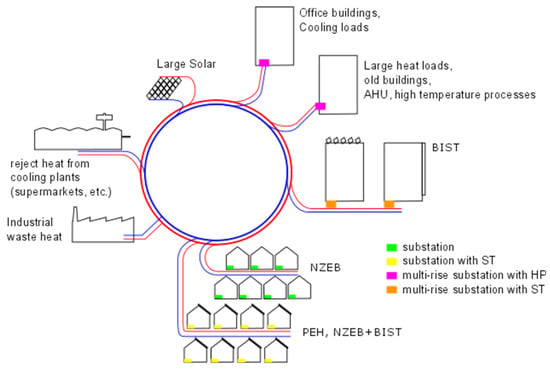Abstract
District heating networks deliver around 13% of the heating energy in the EU, being considered as a key element of the progressive decarbonization of Europe. The H2020 REnewable Low TEmperature District project (RELaTED) seeks to contribute to the energy decarbonization of these infrastructures through the development and demonstration of the following concepts: reduction in network temperature down to 50 °C, integration of renewable energies and waste heat sources with a novel substation concept, and improvement on building-integrated solar thermal systems. The coupling of renewable thermal sources with ultra-low temperature district heating (DH) allows for a bidirectional energy flow, using the DH as both thermal storage in periods of production surplus and a back-up heating source during consumption peaks. The ultra-low temperature enables the integration of a wide range of energy sources such as waste heat from industry. Furthermore, RELaTED also develops concepts concerning district heating-connected reversible heat pump systems that allow to reach adequate thermal levels for domestic hot water as well as the use of the network for district cooling with high performance. These developments will be demonstrated in four locations: Estonia, Serbia, Denmark, and Spain.
1. Introduction
The objective of limiting global warming below 2 °C needs critical actions to reduce greenhouse gas (GHG) emissions [1]. The European Union (EU) is focusing on the mitigation of GHG emissions by at least 80% by 2050 relative to 1990 levels. One of the EU’s strategies is the progressive transformation from a fossil-based to a renewable-based energy system. In this context, at the urban scale, where up TO 80% of global energy is consumed [2], the further development of district heating (DH) systems is crucial, with a need to evolve into smart energy systems with a low carbon footprint [3,4].
The decarbonization of DH systems relies on three pillars: at the production side, with a replacement of the actual generation mix based on fossil fuels by a renewable energy source (RES)-based energy mix and the improvement of energy efficiency in the production systems; at the consumption side, reducing the energy demand with the development of nearly zero and positive energy buildings; and at the distribution side, reducing energy losses [3,4,5]. These aspects will be enhanced by the reduction in supply temperature levels in DH systems towards the so-called 4th Generation of DH (4GDH) [6,7], which allows for a substantial increase in the use of RESs such as building-integrated solar thermal systems (BISTS) and waste heat (WH) streams, the reduction in distribution losses with operation levels considered as ultra-low temperature (ULT) (45/30 °C), and the decentralization of heat producers. The reduction in the distribution temperature makes the exergy levels of these sources more adequate for their integration, allowing the use of buildings as energetic nodes with bidirectional substations. To ensure proper operation of the DH networks at ULT, the integration of heat pumps (HPs) allows to reach adequate thermal levels for domestic hot water (DHW).
Furthermore, cooling capacities are included in 4GDH, assuming that not only DH but also district cooling (DC) plays an important role in future sustainable energy systems. In DC networks, the HPs need to have a double function in order to provide cooling, using the network as a condensation sink during summer, being the waste heat from the HP used back on the DH. The operative temperature of ULT DH also favors the integration of district heating-connected reversible heat pump systems (DHRHPs). In this direction, the 2012/27 European Energy Efficiency Directive was enacted in favor of the residential energy consumption from HPs as an alternative option for space heating in buildings due to the proven high efficiency of electric HPs, giving them an essential role in the decarbonization of this sector, allowing the electrification of the demand. The consumption of electricity, with higher prices than fossil fuels, is compensated by better performance [8] and allows to couple the distribution at low temperatures and the compliance with DHW directives, with DHRHPs being the system in charge of providing cooling.
In contribution to these developments, the RELaTED project seeks to reduce the supply temperatures of DH down to 50 °C, developing proper substations and building-integrated solar thermal systems (BISTS) that are able to inject the energy into the DH network, as well as integrating DHRHPs developed specifically for the project. The project will be demonstrated in four selected locations: Green field development in Vinge (Denmark); a DH network with a large share of biomass in Tartu (Estonia); a large DH network with incorporation of large RES resources in Belgrade (Serbia); and a corporate DH network in Iurreta (Spain).
In the present paper, the work under development in the RELaTED project for the contribution to the above described developments is described.
2. Main Concepts
The RELaTED project aims to increase the replicability of 4GDH in the context of ULT DH. For this purpose, four main concepts have been developed in parallel:
Reduction in DH operative temperature
The reduction in the distribution temperature allows the network to be operated in a decentralized manner, with buildings acting as energetic nodes and with the integration of nearby low-exergy WH streams from industrial processes. Additionally, a micro booster HP is used directly to increase the temperature of the DHW so that risk of legionella is avoided, as well as to reach the required comfort temperature in case the DH is not capable of delivering the demanded thermal levels.
Building-integrated solar thermal systems
In opposition to large solar thermal systems that need to be installed far away from the urban area, BISTS are easily integrated on roofs and façades [9]. Regarding thermal collectors’ technology, the three main types (unglazed, glazed, and evacuated tube collectors) are suitable for BISTS applications for integration with ULT DH networks. Specific technologies will be developed within RELaTED.
Combination of BISTS and ULT DH
With an increased share of nearly zero-energy buildings (NZEBs) in districts acting as prosumers, heat production may frequently exceed local needs, especially in combination with large BISTS. Furthermore, during consumption peaks or low production periods (due to, for example, low irradiation), the distributed heat sources may not be able to cover the whole demand. DH is a plausible technical solution to solve these obstacles, taking profit of the surplus heat as thermal storage and acting as a back-up system delivering complementary heat during peak consumption periods without solar radiation (e.g., in winter).
RELaTED studies the possibility to incorporate solar thermal collectors in the context of future ULT DH, assessing the performance of façade-integrated solar thermal systems in combination with ultra-low temperature DH networks. The studies concluded that all solar systems proposed increase efficiency levels when connected to a DH network. This performance increase is even more remarkable when the connection is made to the return line of the network and with limited temperature rise [10]. For this purpose, a novel three-function scheme (3FS) substation is being developed within RELaTED, allowing different operation modes between the grid and the building according to the temperature level and demand range at every moment.
The RELaTED project seeks to ensure the proper use of DH in combination with the innovative BISTS with a full interconnection of BISTS, DH, and building in central manifolds/substations, allowing a novel combination of heat directionality, both from building to the heat grid and vice versa, as shown in the Figure 1. Fully integrated systems are estimated to produce a 50% higher surplus of energy than other connections.

Figure 1.
Proposed substation concept with a three-pipe arrangement. The proposed substation configuration is based on a three-heat exchanger concept that makes the circuits independent: space heating, domestic hot water (DHW) and solar thermal (ST) system. The three-pipe configuration allows that the ST heat can be delivered either at high or low temperature levels.
This substation enables the direct use from the solar field to fill the building demand, when temperature ranges permit it. When the solar production is not enough to cover the full heating demand of a building, the DH supplies the rest of the energy needed. This is possible by the bi-directional function that enables shifting the heat from DH to the building (peak of consumption or low production) and from the building to the DH (surplus production). Furthermore, for the optimization of the system, it is permitted to inject the heat both to the supply line and to the return line of the low temperature district heating in function of the temperature range of the moment. For this purpose, reversible water pumps are incorporated, which allow pumping water in both directions.
District heating-connected reversible heat pump systems
The use of DHRHP allows:
- The integration of low-exergy WH streams, connecting them to the residual heat of industrial processes to carry out heat recovery, boosting heat, for example, from 40 °C to the DH operating levels, as shown in Figure 2. The compatibilization of heat sources and loads is made with coefficient of performance levels of 6–7 all-year-round.
 Figure 2. Integration of nearby-low exergy waste heat (WH) streams from industrial processes, using the heat pump (HP) to boost the excess heat from flue gasses from 10 to 15 °C to 45 °C.
Figure 2. Integration of nearby-low exergy waste heat (WH) streams from industrial processes, using the heat pump (HP) to boost the excess heat from flue gasses from 10 to 15 °C to 45 °C. - Boosting heat from ULT until consumption requirement at building level, especially in DHW applications to avoid health issues.
- Providing cooling using the DH as a sink for heat evacuation (condensation).
All the above concepts are summarized in Figure 3.

Figure 3.
Schematic for the 4th Generation of DH (4GDH) concepts proposed in RELaTED.
3. Conclusions
The present paper introduces the main work developed so far within the RELaTED project on the path of 4GDH and the decarbonization of heat production. The reduction in DH operative temperatures to ULT presents a clear opportunity to operate the network as a decentralized system, with incorporation of distributed sources such as ST and WH streams in the networks. With the integration of BISTS into the DH, both thermal storage and back-up boilers are no longer needed, with the network having both functions. The work developed in the RELaTED project regarding 3FS substations improves the combination of both systems, where the unglazed BISTS are the ones that benefit the most from this combination, reaching performance levels comparable to other ST technologies. Efficiency levels from 44% to 62% are achieved when connected to the return line with limited output temperature.
Regarding DHRHPs, their deployment ensures the recuperation of low-exergy heat sources such as industrial processes as well as the incorporation of cooling services in DH networks.
4. Future Work
Demonstration of the presented concepts will be implemented within (RELaTED, 2017) under a controlled test environment. Within this project, four demonstrations across Europe will be used as experimental sites for the testing, deployment, commissioning, and assessment of ULT DH networks in combination with BISTS and DHRHPs enhanced by 3FS substations. Such work is expected to be finished in 2021.
Author Contributions
Conceptualization, R.G. and V.S.; methodology, R.G.; investigation, A.G.M., M.L., V.S. and O.M.; writing—original draft preparation, A.G.M.; writing—review and editing, A.G.M., R.G. and J.P.S.D.R.; funding acquisition, R.G. and J.P.S.D.R. All authors have read and agreed to the published version of the manuscript.
Funding
This project has received funding from the European Union’s Horizon 2020 research and innovation program under grant agreement No 768567. This publication reflects only the authors’ views and neither the Agency nor the Commission are responsible for any use that may be made of the information contained therein.
Conflicts of Interest
The authors declare no conflict of interest.
References
- The Paris Agreement|UNFCCC. Available online: https://unfccc.int/process-and-meetings/the-paris-agreement/the-paris-agreement (accessed on 18 December 2019).
- European Commission Cities. Available online: https://ec.europa.eu/clima/policies/international/paris_protocol/cities_en (accessed on 19 December 2019).
- Lund, H.; Werner, S.; Wiltshire, R.; Svendsen, S.; Thorsen, J.; Hvelplund, F.; Mathiesen, B.V. 4th Generation District Heating (4GDH): Integrating smart thermal grids into future sustainable energy systems. Energy 2014, 6, 1–11. [Google Scholar] [CrossRef]
- Li, H.; Nord, N. Transition to the 4th generation district heating—Possibilities, bottlenecks, and challenges. Energy Procedia 2018, 149, 483–498. [Google Scholar] [CrossRef]
- Directive 2010/31/EU of the European Parliament and of the Council of 19 May 2010 on the Energy Performance of Buildings (Recast); Official Journal of the European Union: Brussels, Belgium, 2010.
- Ancona, M.A.; Branchini, L.; de Pascale, A.; Melino, F. Smart district heating: Distributed generation systems’ effects on the network. Energy Procedia 2015, 75, 1208–1213. [Google Scholar] [CrossRef]
- Lund, H.; Østergaard, P.A.; Chang, M.; Werner, S.; Svendsen, S.; Sorknæs, P.; Thorsen, J.; Hvelplund, F.; Mortensen, B.O.G.; Mathiesen, B.V.; et al. The status of 4th generation district heating: Research and results. Energy 2018, 164, 147–159. [Google Scholar] [CrossRef]
- Eguiarte, O.; Garrido-Marijuán, A.; de Agustín-Camacho, P.; del Portillo, L.; Romero-Amorrortu, A. Energy, Environmental and Economic Analysis of Air-to-Air Heat Pumps as an Alternative to Heating Electrification in Europe. Energies 2020, 13, 3939. [Google Scholar] [CrossRef]
- Belusko, M.; Saman, W.; Bruno, F. Roof integrated solar heating system with glazed collector. Sol. Energy 2004, 76, 61–69. [Google Scholar] [CrossRef]
- Lumbreras, M.; Garay, R. Energy & economic assessment of façade-integrated solar thermal systems combined with ultra-low temperature district-heating. Renew. Energy 2018. [Google Scholar] [CrossRef]
Publisher’s Note: MDPI stays neutral with regard to jurisdictional claims in published maps and institutional affiliations. |
© 2020 by the authors. Licensee MDPI, Basel, Switzerland. This article is an open access article distributed under the terms and conditions of the Creative Commons Attribution (CC BY) license (https://creativecommons.org/licenses/by/4.0/).